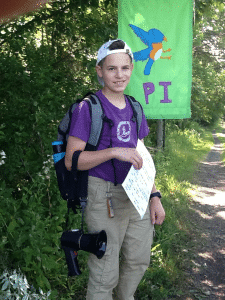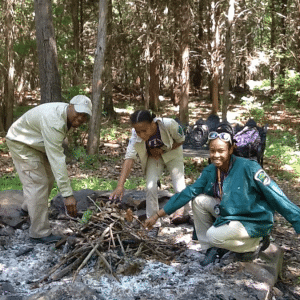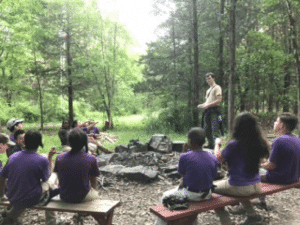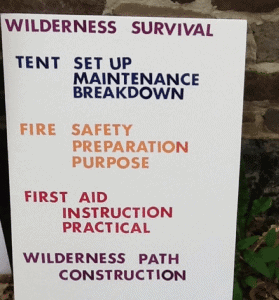First Kids in the Forest
We live in a time where children no longer live in bare feet from April to September, climb trees, build forts, or play capture the flag until their parents order them in at night. Many children now live in a virtual world.

Alan, a Senior Naturalist, armed with his camera and megaphone, welcomes visitors to The Pioneer Institute
Does it have to be that way?
Can our children get mud on their feet, have the thrill of climbing a tree and the joy of finding a nest with four little bluebirds?
One week every year the kids of our little school eat, sleep and adventure in the woods.

The Eastern Box Turtle is a perennial favorite as he always makes an appearance right on time – Eivissa gives him a warm greeting
During the school year, our students study scientific classification. They study the Phyla, Classes, Orders, Families, Genera, and Species of the Animal and Plant Kingdoms.
In June each year, we are privileged to be able to live in the wild and study animals and plants in their natural surroundings.

Arthropoda, Insecta, Lepidoptera, Papilionidae, Papilio polyxenes
Teaching Natural History is easy and great fun with students who already know many animals and plants, and lots of interesting facts about them.

A crayfish is found in the creek and recorded

Our young naturalists keep a careful record each year of every species sited and all botanical identifications made

Our senior students and alumnae set up camp on Sunday for the intermediate and junior students who will arrive first thing Monday morning.

Never a dull moment: Each minute of the day is used for search and discovery and enrichment

Our naturalists erect the tents, unload and organize the supplies for the week, and create the campfire for cooking and sing-alongs.

Ben, ETI alumnae and Life Scout instructs the naturalists in fire safety

Ariana and Jaylen’s Father instructed us once again in the ancient martial art of Shotokan, here Ariana instructs her students.
After completing Environmental and Personal Excellence Checklists to make sure that everything is in perfect order and ship-shape, we have breakfast, and Natural History field study gets underway.

The students are divided into teams, with special projects to accomplish.

The Wilderness Survival Team maintains the tents, builds and rebuilds the campfire, and provides instruction in First Aid and survival. Here Ariana and Hannah demonstrate how to pick up an injured or unconscious person from the ground safely taught by Victoria, alumna and U.N. Field Security Officer

The Wildlife Preservation Team Alan and Ana check our Eastern Bluebird Box Trail and make sure all is well. The Eastern Bluebird, once one of the most common birds here, was on the endangered species list due to loss of habitat.

Thousands of bird lovers have come to the rescue to build bluebird boxes (our young naturalists among them) and now the bluebird is coming back.

The Fine Arts Team enjoys making watercolor paintings of familiar and new species that are identified, and takes photos of the animal and plant life observed.

Yvonne draws the Cardinal Grosbeak

The Basic Needs Team prepares breakfast, lunch, and dinner, and nutritious snacks before and after hiking. The menu this year was gluten- and dairy-free, and delicious! Our Chef, Esteban prepares a delicious and nutritious meal.

Our students add Milkweed plants to our wilderness property to help save the Monarch Butterfly. The Monarch lays its eggs and feeds its larva exclusively on the Milkweed. As more and more cultivated lawns replace fields of wild Milkweed, the Monarch population is dwindling.
Last year the National Wildlife Federation certified The Institutes campus in Wyndmoor, PA, for its chemical-free campus that feeds and shelters animals and plants.
Now The Wildlife Preservation Team is working on gaining certification for our Pioneer Institute property as well.

We have begun the process of the identification of every major tree.
Some special outings including fishing at a nearby lake, and even a night hike through the forest.
On Friday morning, the young students of our Early Development Program and their mothers and fathers arrived for the annual Natural History Tour. The tour is provided by the junior and intermediate students, supported by the fine coaching of the senior students.
Presentations
This year’s Natural History Tour included learning about Poison Ivy, Poison Sumac, and Poison Oak, and their natural remedies, our Bluebird Preservation Project, wildflower identification, a study of birds of prey in the local area, a study of animal tracks and mammal bones found in the forest, the creation of a wilderness shelter, and how to apply first aid in the woods. Then the students gathered around the fire to learn about fire safety.

Ruthie and Jaylen give an impressive presentation on finding and identifying bones in the forest. Thanks to their efforts their young students were able to find deer antlers, leg bones and quite a number of skulls that had been skillfully salted on the forest floor for discovery providing quite a thrill for the young naturalists.

Yvonne and Joelle teach the identification of poison ivy, oak and sumac – an essential skill to safely navigate a forest in Pennsylvania where these toxic plants can be dangerous.

Taiga, our exchange student from Japan, gives a presentation on the Redtailed Hawk assisted by Esteban

An important part of wilderness survival is being able to construct a shelter to survive difficult circumstances. Here Raphael stands in his own shelter with a fire place ready to provide heat and a place to cook.
Awards
Finally, awards were presented to Junior, Qualified, and Senior Naturalists and three new Senior Counselors were recognized. These awards reflect the knowledge gained, work completed, and problems solved but most especially social excellence and maturity on the part of every naturalist. The students learn that real pleasure comes when everyone is happy and winning.
2017 Naturalist Awards
Junior Naturalist: Taiga
Qualified Naturalists: Ruthie, Jaylen, Thomas
Senior Naturalists: Yvonne, Ana, Hannah
Senior Counselor: Alan, Ariana, Esteban

Jaylen is officially recognized as a Qualified Naturalist

Esteban receives the highest honor, the Senior Counselor level, and is congratulated by Susan Aisen, the Natural History sensei and director of the week in the wild.
Every child should have a chance to experience the peace and beauty of the natural world.

Each year a new banner is created that symbolizes what was learned that year.
The week came to an end, with thoughts and expectations about what we would see, do, and discover next year.
Whether a child comes from the city or the suburbs, it does not take long for Mother Nature to work her magic. Within a few days every child is in love with the trees, the flowers, and the many creatures that they see. There are so many problem-solving opportunities in the wild that the child would not encounter anywhere else. Whether it is a one-hour hike in the woods or a two-week campout on a lake, every child should have a chance to experience the peace and beauty of the natural world.
It is their birthright.

The oldest, Esteban, and the youngest camper, Ronald, celebrate a great week together.

 Donate
Donate








